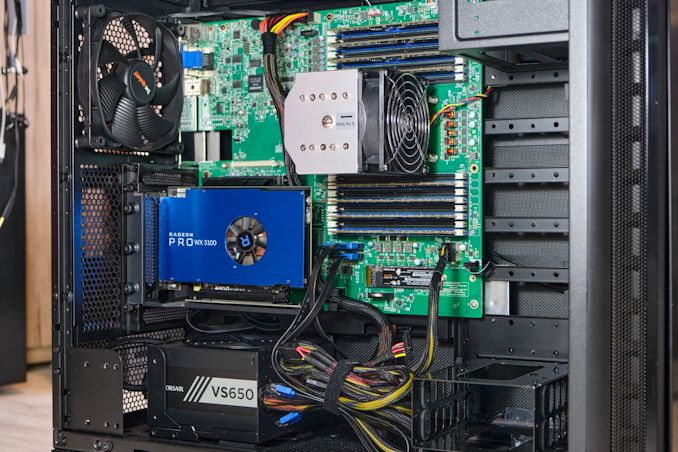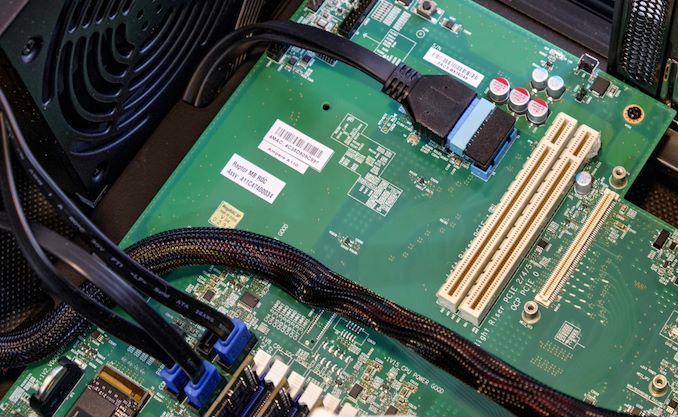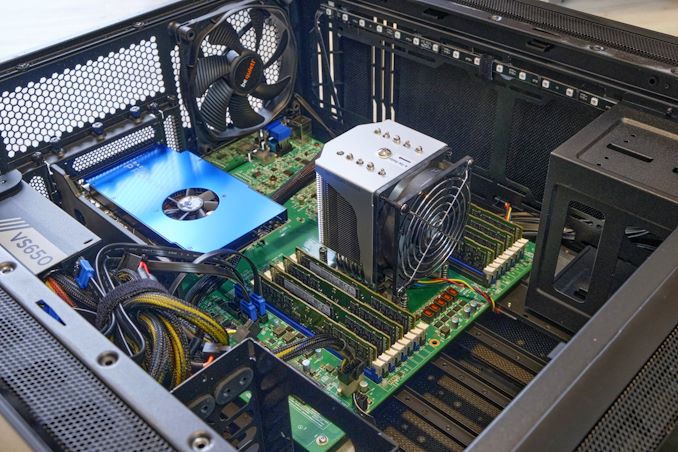Avantek's Arm Workstation: Ampere eMAG 8180 32-core Arm64 Review
by Andrei Frumusanu on May 22, 2020 8:00 AM EST
Arm desktop systems are quite a rarity. In fact, it’s quite an issue for the general Arm software ecosystem in terms of having appropriate hardware for developers to actually start working in earnest on more optimised Arm software.
To date, the solution to this has mostly been using cloud instances of various Arm server hardware – it can be a legitimate option and new powerful cloud instances such as Amazon’s Graviton2 certainly offer the flexibility and performance you’d need to get things rolling.
However, if you actually wanted a private local and physical system, you’d mostly be relegated to small low-performing single-board computers which most of the time had patchy software support. It’s only been in the last year or two where Arm-based laptops with Qualcomm Snapdragon chips have suddenly become a viable developer platform thanks to WSL on Windows.
For somebody who wants a bit more power and in particular is looking to make use of peripherals – actively using large amounts of storage or PCIe connectivity, then there’s options such as Avantek’s eMag Workstation system.
The system is an interesting mish-mash of desktop and server hardware, and at the centre of it all enabling is Ampere’s “Raptor” motherboard containing the eMAG 8180 32-core chip. This is a server development board that doesn’t really adhere to any standard form-factor standard, but Avantek was able to make it fit into BeQuiet tower chassis with some modifications.
Ian had published a more in-depth visual inspection of the machine a few weeks ago, so I recommend reading that in terms of the analysis of what’s physically present in the machine and its quirks.
Read: Arm Development For The Office: Unboxing an Ampere eMag Workstation
The notable characteristics of the system is that in fact it’s a setup that was designed by a vendor that’s usually server oriented – this is Avantek’s first foray into a desktop system.
As noted, because the motherboard isn’t adhering to an ATX standard, the biggest incompatibility lies on the part of the PCIe slots which don’t match up with the slots of the chassis. Avantek here had to resort to using a riser card and a custom backplate in order to fit the graphics card.
The graphics card provided in our sample was a Radeon Pro WX5100 – a lower-end unit meant for workstations.
The biggest advantage of the system which we’ll address in more detail in a bit, is the fact that this is an SBSA (Server Base System Architecture) compliant system, which means it’ll be compatible with “most” PCIe hardware out there. For example, I had no issues replacing the graphics card with an older Radeon HD 7950 I had lying around and the system booted with display output without any issues. This might sound extremely boring, and it is – but for the Arm ecosystem it’s been a decade long journey to reach this point.
In terms of general form-factor, Avantek’s choice here to go with a desktop chassis works well. It’s a big motherboard so it does require a bigger case, allowing it for plenty of additional hardware inside.
I think one negative on the system from a practical hardware perspective is Avantek’s server pedigree. The CPU cooler in particular is the type you’d find in a server system, and the fan choice isn’t something you’d see in any traditional desktop system as it's a more robust 90mm fan. Although the company has said that it tried to minimise the noise of the system by adjusting the fan curves as well as opting for a low acoustics chassis – it’s still subjectively loud for a desktop system. I measured around 42dBA at idle which is still a bit much - but that also depends on your typical expectations of a silent system. I hope Avantek would change in the future is employ a more consumer grade CPU cooler system and reduce the acoustics of the machine.















35 Comments
View All Comments
SarahKerrigan - Friday, May 22, 2020 - link
The X-Gene microarchitecture was never particularly stellar and by the time eMag rolled around it was woefully obsolete. I did some testing on eMag a few months back and it was pretty dire. When I spent some time on Graviton2 last week, it was like night and day compared to eMag (frequently 2+ times the single-thread perf despite a much lower clock), so I have high hopes for Altra.SarahKerrigan - Friday, May 22, 2020 - link
By the way, Andrei, you may want to correct the ST SPECFP subtest result graph - it looks like you used Graviton as a template and forgot to change the labels to eMag, because right now it only mentions Graviton1, and Graviton2, and Intel, not eMag.Andrei Frumusanu - Friday, May 22, 2020 - link
Thanks, good catch.Flunk - Friday, May 22, 2020 - link
Interesting to see even if this hardware only makes sense for very specialized purposes. ARM processors have gone from only applicable to mobile devices to something that would have made sense in a server a few years ago.SarahKerrigan - Friday, May 22, 2020 - link
This isn't exactly a good representative of ARM processors; chips like Graviton2 are competitive for server workloads today, and make eMag look like a toy by comparison.eastcoast_pete - Friday, May 22, 2020 - link
Thanks Andrei, good and in-depth review! You and others here have already commented on the great difference of this legacy CPU to Ampere's Altra or Amazon's Graviton 2. What I am also very curious about is Fujitsu's ARM-based multicore CPU (A64FX). Amongst other features, it supports 512-bit scalable vector extensions (SVEs), so same width as Intel's AVX512. I wonder if someone at Fujitsu reads Anandtech, and maybe send you a setup for review, although a PRIMEHPC might be out of the scope here. Still, that's an ARM v8 design that should beat the Graviton 2 and the Altra, especially if applications can make use of the wide SVEs.anonomouse - Friday, May 22, 2020 - link
Based on what we know of the A64FX, it’ll almost certainly *only* beat Graviton 2/Altra in cases where it can heavily utilize wide vectors. In all other scenarios it really doesn’t have a lot of execution width, and only runs at 2.2Ghz. The disclosures in their Microarchitecture guide also don’t showcase anything impressive looking on the branch predictor, which is fine for the typical HPC workloads it will run. That thing is very heavily purpose designed for HPC, and it’s clear they focused on that and not general performance.SarahKerrigan - Friday, May 22, 2020 - link
Indeed. It's a specialized chip. I would expect no miracles from it on general-purpose loads.eastcoast_pete - Friday, May 22, 2020 - link
Agree with you and anonomouse on general purpose loads; my interest in wide vectors is mainly due to their utility for video processing and encoding, if (!) the software supports it. For those applications, AVX512 is what keeps Intel competitive with EPYCs in the x64 space. As a question, is anything like an AV1 encoder even available for ARM v8, and specifically to use wide SVEs?Wilco1 - Saturday, May 23, 2020 - link
There are many AV1 codecs which have AArch64 optimizations, but most focus on older mobile phone cores (eg. http://www.jbkempf.com/blog/post/2019/dav1d-0.5.0-... ), so likely need further work on latest microarchitectures with up to 4 128-bit Neon pipes.It's early days for SVE, the first version (as in A64FX) is aimed at HPC. Video codecs will be optimized for SVE2 when hardware becomes available.